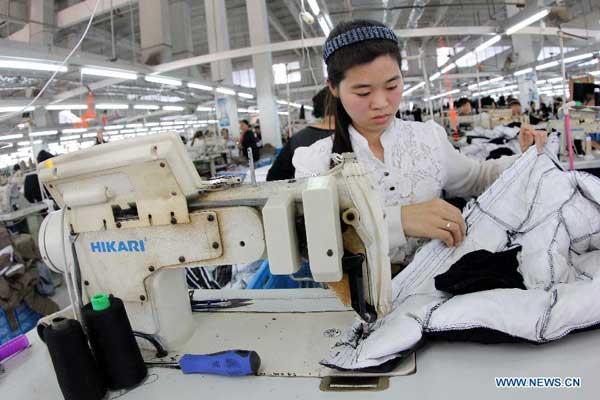Advanced manufacturing may change the rules of economic development
- By Dan Steinbock
 0 Comment(s)
0 Comment(s) Print
Print E-mail Shanghai Daily, May 13, 2016
E-mail Shanghai Daily, May 13, 2016
|
|
| A woman works in a clothing factory at Shahe Town of Ganyu County in Lianyungang City, east China's Jiangsu Province, Oct. 13, 2013. [Xinhua/Si Wei] |
As advanced manufacturing is about to accelerate in China, the rules of economic development could change across the world.
About a year ago, China’s State Council unveiled a national plan, “Made in China 2025,” which seeks to upgrade China’s manufacturing base. The ultimate objective is to transform China into the leading global manufacturing power by 2049.
The booming robotics is a prime example. China is already the world’s largest robotics market. By the year-end, it is expected to become the world’s leading producer. Foreign industry pioneers are giving way to Chinese robotics giants, such as Shenyang Siasun and Ningbo Techmation’s subsidiary E-Deodar. Chinese companies have begun acquisitions in both industrial and service robotics.
Yet, Chinese innovation differs from its precursors and will have broader implications.
Manufacturing innovation – with Chinese characteristics
From the mass production of cars in 1930s Detroit to social media in Silicon Valley, corporate innovation, venture capital and angel investors have played a vital role in financing start-ups in the US. Chinese innovation draws from the American experience. It has also been inspired by Germany’s recent “Industry 4.0” plan in which intelligent manufacturing has a central role.
Yet, the context of upgrading is unique in China. As innovation took off in the mainland about a decade ago, it was still the “world’s factory" and cheap prices reigned. Industry was dominated by state-owned-enterprises; venture capital was minimal and individual riches rare. However, Chinese innovation has taken leaps since the early 2000s.
Today, China's R&D as share of the economy exceeds 2% and is higher than in Europe. True, the density of robots in Japan and South Korea is still 10-13 times higher than in the mainland. But China’s population base offers a huge basis for mass production and markets, and an export platform. As a result, Chinese robotics is positioned to grow by a magnitude.
Due to systemic differences, public sector plays a central role in Chinese innovation. While corporate innovation, venture capital, even angel investors, have a growing role in China, central government has a prime role as a catalyst, in basic R&D and certain strategic areas, whereas local governments play a vital role as kind of public-sector venture capitalists in commercial R&D.
With innovation, there will always be both hits and misses. However, if China did not try to scale up its industrial capacity in promising emerging industries, it would remain just a consumer of advanced technology and dominated by foreign companies, with profits flowing out.




 Add your comments...
Add your comments...

